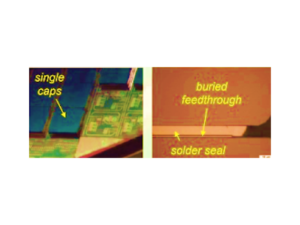Reliable Cavity Electronic Packaging with LCP-Grade Lid-Sealing Adhesive-Sealant with Matching Moisture and Corrosive Gases Barrier
Near-Hermetic Cavity Electronic Packaging with Low-Temperature Low Moisture Permeability Adhesive Lid-Sealing vs Traditional Solder or Glass-Frit Lid-Sealing:
- Traditional AuSn and glass-frit lid-sealing provide outstanding hermetic lid-sealing with 80-100µm sealing width. Costs and lid-sealing at near 300°C are some of its limitations for high volume commercial applications.
- Traditional epoxy adhesive lid-sealing for near-hermetic applications using controlled pressurization and lower temperature of less than 150°C have been proven reliable enough for most applications.
- For some of the more advanced applications such as optical imaging devices and automotive electronic sensor devices that required high moisture barrier and higher temperature operation to 175°C, lid-sealing adhesive with much lower moisture permeability and higher temperature tolerance are critical for their success.
- FLUOROSEAL® paste and film are proven lid-sealing adhesive and coating that are molecularly designed to meet the more stringent requirement. They block moisture that carries with it the corrosive sulfur and other acidic gases while contributing close to zero sodium, chloride, and other circuit damaging ions.
Proven Moisture Blocking Cavity Electronic Packaging Lid-Sealing Adhesive and Coating:
Cavity electronic packaging is more susceptible to corrosion-related reliability issues than fully encapsulated and molded electronic packaging if moisture and corrosive gases are not prevented from entering the cavity packaging. Fully encapsulated electronics with molding or glob-top protections provide more limitation to the mobility of ionic, moisture, and corrosive gases penetration into the electrical contacts inside the packaged devices.
Epoxy-based lid-seal adhesives or coatings allow substantial moisture penetration and also retain from 0.3-1.0% of moisture in the material. FLUOROSEAL® paste and film adhesives are molecularly designed to have low moisture permeability to effectively block moisture from penetration when the cavity is backfilled with a nitrogen atmosphere. This moisture blocking capability has been measured to match that of the liquid crystal polymers to form near hermetic seal for air cavity electronic packages. The following is a pictorial representation of the difference between typical epoxy-based and other typical polymers used for moisture barrier against the same thickness of LCP and FLUOROSEAL®. While none of them reaches a hermetic level, there are several hundred folds differences between the LCP and epoxy-based barrier.
Barrier against moisture or water Moisture permeability for polymer film is highly dependent on the “volume of free-space” and molecular pore sizes based on the molecular structure and conformation. They can be more than 10,000 times different.
- PVDC (“Saran Wrap”) and PET bottles are commonly used materials to keep moisture (H2O) out and CO2 in respectively.
- LCP and highly fluorinated polymer are among the best in blocking moisture and thus also corrosive gases out.
Moisture barrier capability depends on molecular structure and is not the same for all lid-seal adhesive and or sealants:
- Epoxy lid-seal is a fundamentally amorphous polymer with relatively high free-space in the adhesive polymer network and has high moisture permeability.
- FLUOROSEAL® is molecularly engineered with high fluorination with low free space to match the best LCP molded package and lid.
- When batch or inline isothermal lid-sealed with backfilling N2 during the lid-bonding process, the cavity formed a high barrier to keep the backfilled N2 and corrosive gases with much larger molecular “kinetic diameter” inside while not allowing the smaller “kinetic diameter” moisture molecules to get inside the package.
Nitrogen (N2) is an inert gas that has a larger molecular kinetic diameter than moisture. It is ideal for backfilling gas inside the cavity in blocking moisture penetration after lid-sealing.
- Keeping the sealing cavity temperature the same as surrounding air, and
- blanketing the surrounding air outside of the cavity with nitrogen, are critical for pin-hole-free and reliable device lid-sealing.
- That is, having the inside of the cavity electronic packaging full of N2 gases along with a high moisture barrier to keep moisture out and an even better barrier in keeping the N2 gases in will provide hermetic-like cavity electronic packaging reliability.
- At the same time, FLUOROSEAL has been proven to block H2S, SO2, Cl2, NO and CO, CO2 types of corrosive gases out of the cavity electronic packaging.



